人教版八年级英语下册第一单元教案word版本
- 格式:doc
- 大小:137.01 KB
- 文档页数:13
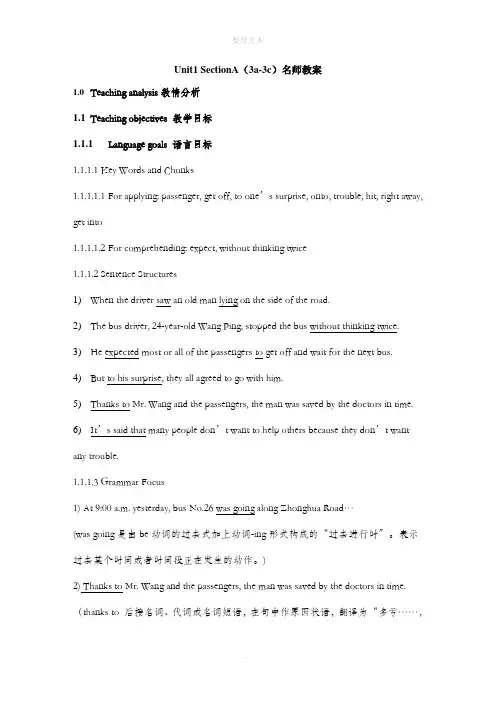
Unit1 SectionA(3a-3c)名师教案1.0Teaching analysis教情分析1.1Teaching objectives 教学目标1.1.1Language goals 语言目标1.1.1.1 Key Words and Chunks1.1.1.1.1 For applying: passenger, get off, to one’s surprise, onto, trouble, hit, right away, get into1.1.1.1.2 For comprehending: expect, without thinking twice1.1.1.2 Sentence Structures1)When the driver saw an old man lying on the side of the road.2)The bus driver, 24-year-old Wang Ping, stopped the bus without thinking twice.3)He expected most or all of the passengers to get off and wait for the next bus.4)But to his surprise, they all agreed to go with him.5)Thanks to Mr. Wang and the passengers, the man was saved by the doctors in time.6)It’s said that many people don’t want to help others because they don’t want any trouble.1.1.1.3 Grammar Focus1) At 9:00 a.m. yesterday, bus No.26 was going along Zhonghua Road…(was going是由be动词的过去式加上动词-ing形式构成的“过去进行时”。
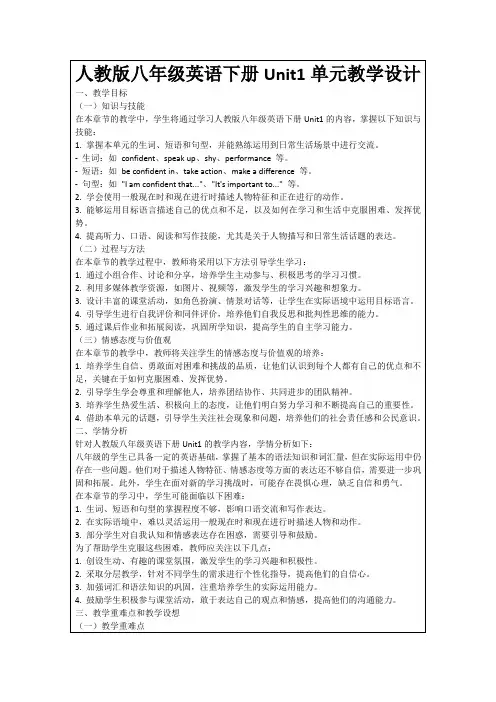
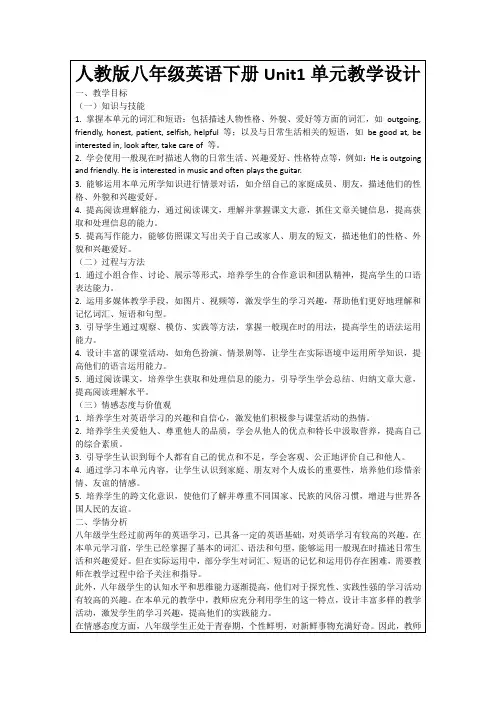
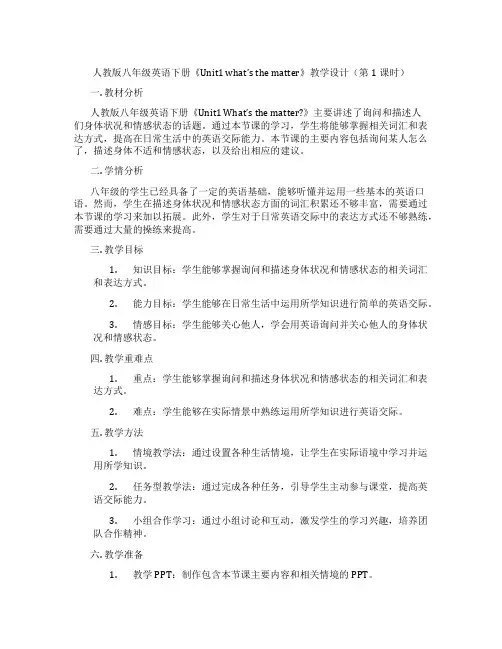
人教版八年级英语下册《Unit1 what’s the matter》教学设计(第1课时)一. 教材分析人教版八年级英语下册《Unit1 What’s the matter?》主要讲述了询问和描述人们身体状况和情感状态的话题。
通过本节课的学习,学生将能够掌握相关词汇和表达方式,提高在日常生活中的英语交际能力。
本节课的主要内容包括询问某人怎么了,描述身体不适和情感状态,以及给出相应的建议。
二. 学情分析八年级的学生已经具备了一定的英语基础,能够听懂并运用一些基本的英语口语。
然而,学生在描述身体状况和情感状态方面的词汇积累还不够丰富,需要通过本节课的学习来加以拓展。
此外,学生对于日常英语交际中的表达方式还不够熟练,需要通过大量的操练来提高。
三. 教学目标1.知识目标:学生能够掌握询问和描述身体状况和情感状态的相关词汇和表达方式。
2.能力目标:学生能够在日常生活中运用所学知识进行简单的英语交际。
3.情感目标:学生能够关心他人,学会用英语询问并关心他人的身体状况和情感状态。
四. 教学重难点1.重点:学生能够掌握询问和描述身体状况和情感状态的相关词汇和表达方式。
2.难点:学生能够在实际情景中熟练运用所学知识进行英语交际。
五. 教学方法1.情境教学法:通过设置各种生活情境,让学生在实际语境中学习并运用所学知识。
2.任务型教学法:通过完成各种任务,引导学生主动参与课堂,提高英语交际能力。
3.小组合作学习:通过小组讨论和互动,激发学生的学习兴趣,培养团队合作精神。
六. 教学准备1.教学PPT:制作包含本节课主要内容和相关情境的PPT。
2.教学素材:准备一些描述身体状况和情感状态的图片或卡片。
3.教学录音设备:用于播放听力材料。
七. 教学过程1.导入(5分钟)教师通过播放一段关于人们描述身体状况和情感状态的听力材料,引导学生关注本节课的主题。
同时,教师可以提问学生:“Can you guess what’s the matter with them?”,激发学生的学习兴趣。
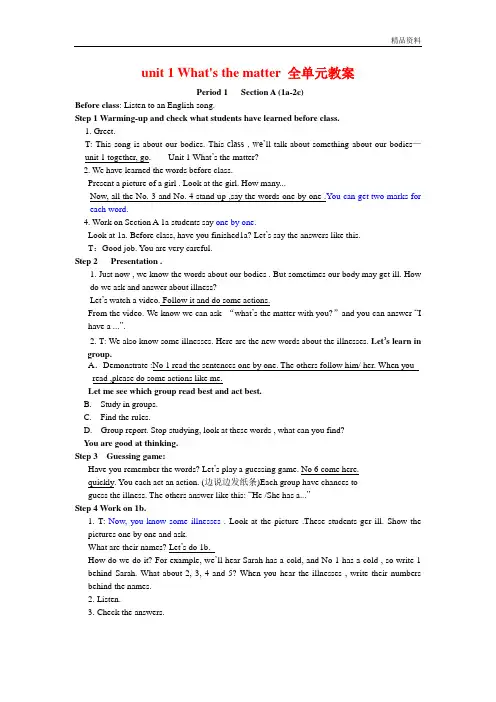
unit 1 What's the matter 全单元教案Period 1 Section A (1a-2c)Before class: Listen to an English song.Step 1 Warming-up and check what students have learned before class.1. Greet.T: This song is about our bodies. This class , we’ll talk about something about our bodies—unit 1 together, go. Unit 1 What’s the matter?2. We have learned the words before class.Present a picture of a girl . Look at the girl. How many...Now, all the No. 3 and No. 4 stand up ,say the words one by one .You can get two marks for each word.4. Work on Section A 1a students say one by one.Look at 1a. Before class, have you finished1a? Let’s say the answers like this.T:Good job. You are very careful.Step 2 Presentation .1. Just now , we know the words about our bodies . But sometimes our body may get ill. Howdo we ask and answer about illness?Let’s watch a video. Follow it and do some actions.From the video. We know we can ask “what’s the matter with you?”and you can answer “I have a ...”.2.T: We also know some illnesses. Here are the new words about the illnesses. Let’s learn ingroup.A.Demonstrate :No 1 read the sentences one by one. The others follow him/ her. When you read ,please do some actions like me.Let me see which group read best and act best.B. Study in groups.C. Find the rules.D. Group report. Stop studying, look at these words , what can you find?You are good at thinking.Step 3 Guessing game:Have you remember the words? Let’s play a guessing game. No 6 come here.quickly. You each act an action. (边说边发纸条)Each group have chances toguess the illness. The others answer like this: “He /She has a...”Step 4 Work on 1b.1. T: Now, you know some illnesses . Look at the picture .These students ger ill. Show thepictures one by one and ask.What are their names? Let’s do 1b.How do we do it? For example, we’ll hear Sarah has a cold, and No 1 has a cold , so write 1 behind Sarah. What about 2, 3, 4 and 5? When you hear the illnesses , write their numbers behind the names.2. Listen.3. Check the answers.Step 5 Group work.1. T: Why do they get ill? Look at the chart, match the reasons with the illnesses.2. Check the answers.3. Demonstrate .Look at the chart. Let’s talk about their illnesses in pairs. Here is the example.Boys ask , girls answer.4. Look at the chart and make more similar conversations.When you talk , please talk loudly, correctly and politely, please do some actions and use the nice intonations.5. Let students show their conversations.Step 6 Work on 2a and 2b.1. T: David has a stomachache, what should he do?Show the pictures ,ask and answer. 板书What should …do? …should….T: Your advice is very useful. Let’s learn more advice from 2a and 2b.2. Listen, finish 2a. What’s the matter with the people? What advice do they get?3. First , guess the answers to 2b. Then listen and check the answers.OK, you have good listening skills.Step 7 Group work.The advice for illness is very useful . It can help us take good care of ourselves and others.T: If some students are ill, will you give some advice and help them? let’s act andmake conversations. Let me see who is the kind person? How do we talk?Look at the example.2. Show the example.When you talk , please talk loudly, correctly and politely, please do some actions and use the nice intonations.3. Students work.4. Let students show their conversations.Step 8 Summarize and homework:1. Summarize.Period 2 Section A 2d,GrammarKnowledge aims:1. The students will be able to learn the words and phrases: take breaks, hurt,2.Summarize the grammar and practice them.3. Target Language:①What’s the matter with Ben? –He hurt himself./ He has a sore back.②-Do you have a fever? -Yes, I do./ No, I don’t.③-Does he have a toothache? -Yes, he does.④You shouldn’t eat so much next time.⑤What should she do?⑥She should take her temperature.⑦-Should I put some medicine on it? -Yes, you should. / No, you shouldn’t.Structure: ①“should/ shouldn’t + verb” for suggestion ②Reflexive pronouns. Ability Object:1.Enable students to talk more about health.2.Learn to give others some advice according to their matters.3.Enable the students to do things using the target language and the grammar. Emotion Object:1.Learn to live in a healthy way.2. Learn to take care of others and themselves.Teaching Key Points:1. How to teach the Ss to learn the names of the illness: toothache, fever andheadache.2. How to give others some advice according to their matters.3. The grammar.Teaching Difficult Points:1.How to give advice using should.2. Use the grammar to do things.Teaching Procedures:Step 1 Review.1. Free-talk. What ‘s the weather like today? If you don’t wear warm clothes,what will happen?2.Show the pictures and say.He / She has_______________. He /She should___________.Step 2 Work on 2d.1. Game.Do in the same way2. Listen to the conversation and answer my questions .1). What's the matter with Lisa?2). What did Lisa do on the weekend?3). What should Lisa do ?3. Role-play the conversation.First, have students to role-play the conversation in 2d in groups and choose the best.Step 3 Group work.1. Give more examples. Have students read the conversation in 4c.2. and then ask them to work in groups. One student mimes a problem. The otherstudents in his/ her group guess the problem and give their advice.Step 4 Grammar Focus .Have students to read and remember the sentences of Grammar Focus by themselves, and then have them work in groups to sum up how to talk about health problems and give right advice.Step5 Work on 4a.Ask students to go through each conversation in 4a quickly, and then complete the conversations individually. Move around the classroom and help them ifnecessary.Check the answers.Ask some students to practice every conversation in pairs.Step 6 Work on 4b.Have students choose and circle best advice for the health problems in 4b. Then ask students add their own advice about these health problems.Have some students to report their own advice in class.Step 7 Summary.Health problems and give right advice.Ask one or two students to sum up the key phrases in the passage, and help them to make up more sentences with them.Step 8 Homework .Have students make up conversations to talk about sb.’s health problems and give them some advice.Period 3 Section A 3aKnowledge aims:The students will be able to learn the words and phrases: passenger, get off, to one’s surprise, onto, trouble, hit, right away, get into.2.The students will be able to use the expressions:The driver didn’t think about thinking about himself. He only thought about saving a life. Ability aims:The students can understand the passage.2.To train the students’ cooperation with their partners.Emotional aims:To train the students to care about others and help others who are on trouble..Teaching important points:The students can understand the passage and use the useful expressions freely.Teaching difficult points:The students can learn from the drivers and do as the driver does if possible.Teaching procedures:Step 1 Warming-up and lead-in.1. Watch a video.2. What is the short sketch about?3.Look at the picture. What can you see? Can you guess what is happening?Step 2 Preparing reading.1. Guess the main idea.What is this passage mainly about?Strategy : The title and pictures can be helpful to understand the text.Title may be the main meaning of the article.2. Read the passage. Do you think it comes from a newspaper or a book?Step 3 While-reading.1.Find the topic sentence(中心句)of each paragraph.1). At 9:00 a.m. yesterday, bus No. 26 was going along Zhanghua Road when the driver sawan old man lying on the side of the road.2). Some passengers helped Mr. Wang to move the man onto the bus.3). Thanks to Mr. Wang and the passengers, the doctors saved the man in time.2. Which sentences touched you? Read them in the way that you like.Step 4 Post-reading.1. Praise the persons.What a great person the driver was!He stopped the bus without thinking twice, when he saw an old man lying on the side of the road.What _______ the _____ was/were!2. Work on 3bAfter checking the answers, have Ss scan the passage and check (√) the things that happened in the story.3. Work on 3c.T: Ask the students to discuss the questions in pairs.Step5 Homework.1. If you are the driver, write a diary about what happened yesterday.2. If you are the passenger, write a diary about what happened yesterday.3. Act the story out in your group.4. Read some messages about good men.Period 4 Section B 1a-1dStep 1 Lead –in and learn the new words.It’s a beautiful song, I like it very much. Let’s learn the new words.1. Who can be the teacher? One student teach one word.2. Let’s sing and remember the new words.The teacher teaches to sing, ask some group to sing. Finally sing together.(可以课前教唱,。
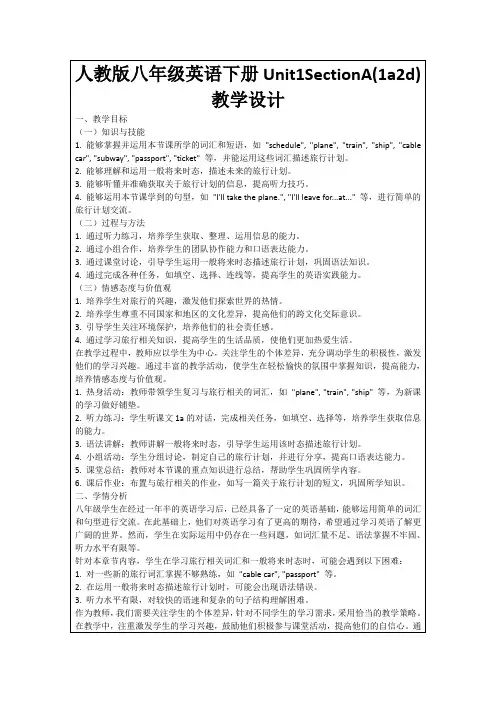
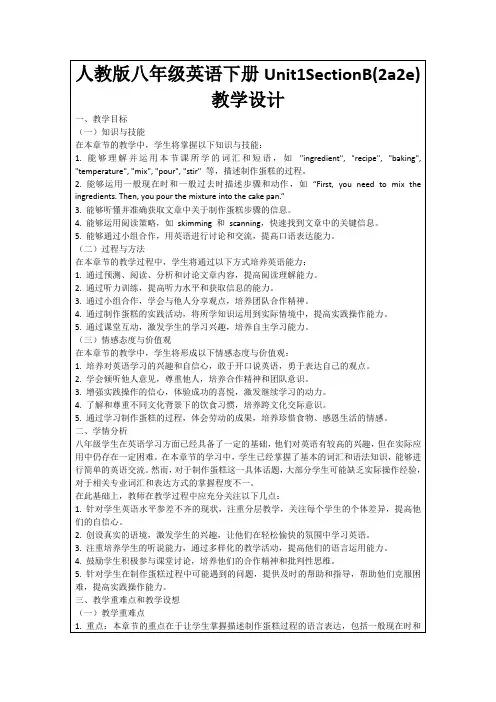
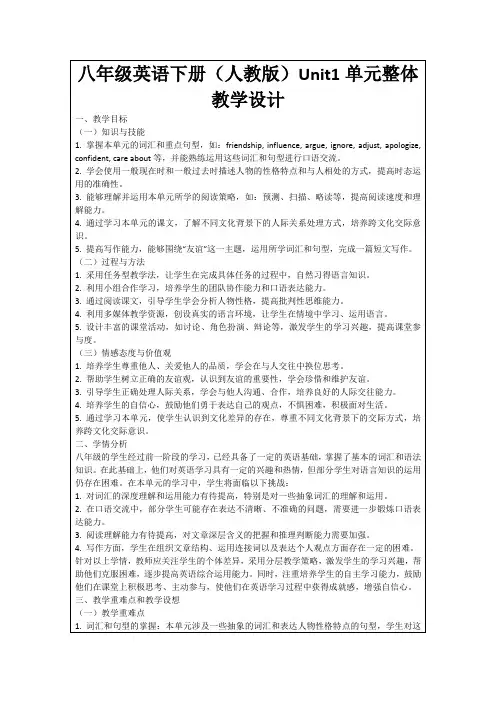
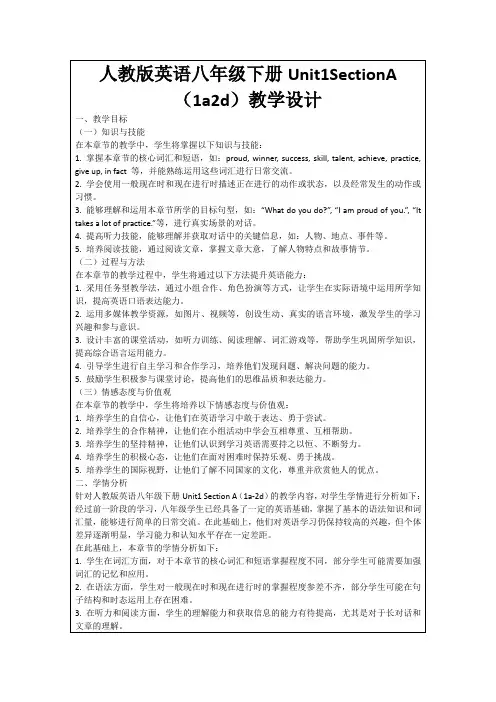
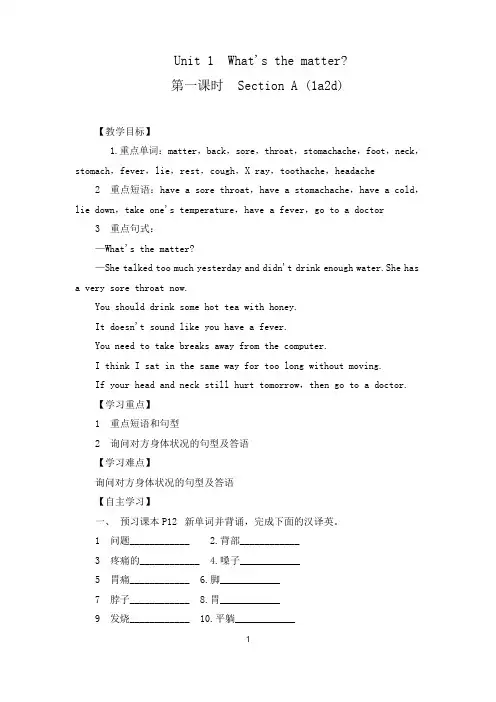
Unit1What's the matter?第一课时Section A(1a2d)【教学目标】1.重点单词:matter,back,sore,throat,stomachache,foot,neck,stomach,fever,lie,rest,cough,X ray,toothache,headache 2重点短语:have a sore throat,have a stomachache,have a cold,lie down,take one's temperature,have a fever,go to a doctor 3重点句式:—What's the matter?—She talked too much yesterday and didn't drink enough water.She has a very sore throat now.You should drink some hot tea with honey.It doesn't sound like you have a fever.You need to take breaks away from the computer.I think I sat in the same way for too long without moving.If your head and neck still hurt tomorrow,then go to a doctor.【学习重点】1重点短语和句型2询问对方身体状况的句型及答语【学习难点】询问对方身体状况的句型及答语【自主学习】一、预习课本P12新单词并背诵,完成下面的汉译英。
1问题____________ 2.背部____________3疼痛的____________ 4.嗓子____________5胃痛____________ 6.脚____________7脖子____________8.胃____________9发烧____________10.平躺____________11休息____________12.咳嗽____________13X光____________14.牙疼____________15头疼____________二、认真预习1a2d找出下列短语和句型。
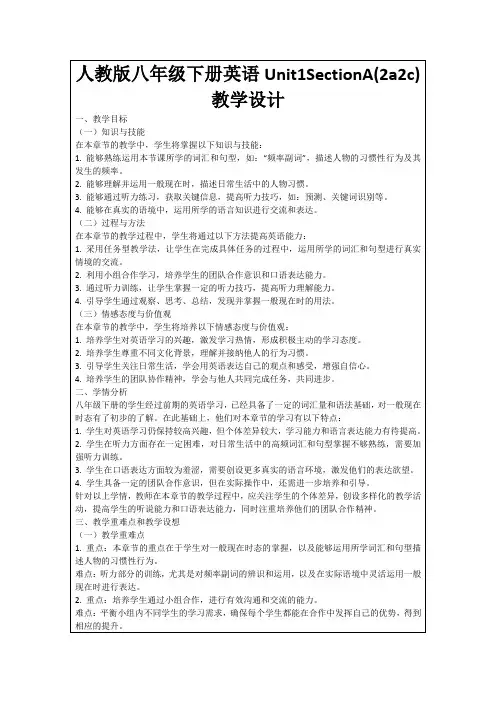
初中英语人教版八年级下册Unit1教案(word版可编辑修改)编辑整理:尊敬的读者朋友们:这里是精品文档编辑中心,本文档内容是由我和我的同事精心编辑整理后发布的,发布之前我们对文中内是任然希望(初中英语人教版八年级下册Unit1教案(word版可编辑修改))的内容能够给您的工作和学习馈,这将是我们进步的源泉,前进的动力。
本文可编辑可修改,如果觉得对您有帮助请收藏以便随时查阅,最后祝您生活愉快业绩进步,以下为初中辑修改)的全部内容。
八年级下册教案学科:英语班级: ________________备课人: ________________Unit 1 What’s the matter?Period 1 Section A 1a-1cTeaching aims:1)Ss can use the following words: head , ear, eye, mo neck, back, hand, arm, leg, tooth-teeth, foot—fee cold, stomachache, , backache, headache, toothache 2)Ss can use the following sentence patterns:What's the matter? I have a stomach./I have a soreHe/She has a sore throat。
Ability aims: Learn how to talk about health problemsImportant & difficult points:Learn how to talk about health, use have to talk abou Teaching aids: recorder, computerTeaching proceduresStep 1 Warming-upSing an English song: If you're happy and you know itStep 2 Word study1.Greeting2.Teach the parts of the body one by one by touching i one, let them touch or show it。
Unit1 What’s the matter?1. KnowledgeWords: have, cold, back, arm, ear, eye, foot, hand, head, leg, mouth, neck, nose, tooth, fever, rest, should, headache, ago, so, illness, thirsty, early, problem, way, traditional, believe, weak, angry, medicine, western, everybody, get, few, stay, important, moment, late, until, yesterday, hearPhrases: have a cold, be stressed out, a few, at the momentStructures: Have for talking about health problems.Modal: should / shouldn’t2. SkillsTalk about your health.Give advice.3. Learning StrategiesUsing what you know.Inferring content.II. BackgroundIII. Teaching Time: Six PeriodsPeriod OneTeaching Aims:1. Learn and master the following words and phrases: matter, have, cold, have a cold, stomachache, sore, back, arm, ear, foot, hand, head, leg, mouth, neck, nose, stomach, tooth, throat2. Develop the students’ listening ability.3. Be able to talk about health.4. Sentence PatternsWhat’s the matter? I have a sore throat.Teaching Difficult PointThe sentence patterns.Teaching MethodsListening practice to train the students’ listening ability.PairwrokTeaching AidsSome pictures.A tape recorder.Teaching ProceduresStep I Greetings.Step II. 1aTeach the students to study the new words by showing some pictures.eye, nose, mouth, ear, tooth, face, head, neck, back, stomach, arm, hand, leg, footAsk a student to read the list of thirteen names of body parts.Then let the students look at the picture and write the correct letter for each part of the body.Check the answers.Answers:k arm c back g ear i eye m foot a hand l head b leg f mouth e tooth d neck j nose h stomach Step III 1bShow some illnesses.e.g. I have a cold. I have a stomachache. Let several students say some illnesses.Ask a student to read the names. Nancy, Sarah, David, Ben, JudyThen play the recording the first time. Students only listen. Play the recording a second time. Students number the names. Cheek the answersAnswers:Nancy = 3 Sarah = 1 David = 2 Ben = 5 Judy = 4Step IV 1cAsk two students to read the conversation.A: What’s the matter?B: I have a sore throat.Then let the students make conversations in pairs.After some minutes, ask several pairs to say their conversations.Explain the language points.1. What’s the matter? 你怎么啦?这句话在口语中很常见,当别人遇到什么麻烦,或身体不舒服,你就可以问What’s the matter?意思是你怎么啦?/ 你遇到什么麻烦啦?/ 你哪儿不舒服?还可以在句末用介词with表示对象。
Unit 1 What’s the matter?教材解读Go for it! 是以任务型语言教学为基础的英语教材,它体现“以学生为中心”和“以人为本”的教学思想,融话题、交际功能和语言结构于一体。
本书每个单元都列出明确的语言目标、主要的功能项目和语法结构、需要掌握的基本词汇,并分为Section A和Section B两部分。
Section A为目标句型提供分步事例和指导性练习;Section B使学生能够对已经学过的目标句型运用自如。
每个单元还附有Self Check部分,此部分是让学生用来测试自己现阶段的英语水平,即对本单元的语言目标的掌握程度有较为明确的认识。
第1单元以What’s the matter?为中心话题,让学生认知表示身体部位的单词以及部分疾病的表达方法,描述身体不适和提出建议展开,学习和运用“What’s the matter?”和“What should…do?”让学生学会描述身体的不适和提出建议。
本课教材内容与学生的实际生活密切相关,易于引出学生运用简单的英语进行交际和交流,在学习活动中,学生通过交换对身体不适的描述及建议,促进学生之间和师生之间的情感交流,增进情谊。
同时,在学习中养成良好的健康习惯。
单元目标一、知识与技能1. 知识目标:认知表示身体部位的单词以及部分疾病的表达方法。
能听懂并描述日常小事故的处理方法。
掌握句型:What’s the matter? I have a stomachache. What should she do? She should lie down and rest.2. 能力目标:能准确描述自己的常见疾病,并能对他人的常见疾病提出合理化建议。
掌握日常小事故的正确处理方法。
培养听、说、读、写四项基本技能。
二、过程与方法灵活运用教材,从所教学生的实际水平和语言能力出发,对教材内容进行整合,删除材料中的听力部分,将其用图片的形式展示出来以保持课堂的完整性。
对教材作适当的修改和扩充,使内容更贴近生活,让学生有更多的发挥空间。
合理安排本单元的课时数,设计好每课时的教学内容。
三、情感态度与价值观1.通过谈论健康问题,增加同学和朋友间的了解,增进友谊。
2. 通过开展扮演病人等活动,培养学生关心他人身体健康的品质。
3. 通过本课的阅读,培养学生处理紧急事件的基本能力,以及发生紧急事件时互相帮助的精神。
教法导航1. 以任务型教学作为课堂教学理念、利用整体语言教学法、情景教学法、交际教学法等。
2. 在教学中创设切实可行的任务型教学活动、突出交际性。
3. 教师为主导、学生为主体、任务为基础,注重实用性。
4. 引趣激趣策略,创设情景调节气氛,引发激发学生兴趣。
学法导航多读善思,小组合作、探究、学习、交流。
课时支配:第1课时:Section A 1a-2d第2课时:Section A 3a-4c第3课时:Section B 1a-2e第4课时:Section B 3a-Self Check课时教案第1课时Section A 1a-2d教学目标一、知识与技能1. 熟练读出,拼写本节课的表示身体部位的单词。
2. 能听懂健康问题及解决建议。
3. 掌握常见的询问健康的问题及答语。
二、过程与方法看图法,对话,做游戏,多种方法并用,促使学生主动探求知识。
三、情感态度与价值观通过学习本课,培养学生关心自己和他人的健康,增进彼此间的友谊。
教学重点学会询问并回答有关健康的问题,并能给出合理的建议。
教学难点掌握重点句型:What’s the matter? I have a fever. You should take your temperature.教法导航通过看图、听录音、对话、讨论等方法学习谈论健康及提出建议。
学法导航通过看、听、说等各种途径,以小组合作的形式,主动探求知识,锻炼自主学习能力。
教学准备图片,多媒体。
教学过程Step 1 Warming up and new wordsLook at a picture and learn the parts of the body. Then show the words on the screen. Ask the students to read and remember them.Step 2 Presentation1a Look at the picture. Write the correct letter [a-m] for each part of the body.___arm ___ back ___ ear ___ eye ___ foot___hand ___ head ___ leg ___ mouth___ neck ___nose ___ stomach ___ toothStep 3 GameAsk all the students to stand up and play a game:The teacher says “head”,then all the students should point at their heads. Then the teacher says other parts of the body. After several times,ask some students to say and the rest students to do the actions.Step 4 Listening1b Listen and look at the picture. Then number the names 1-5.Listen to the conversations again and fill in the blanks.Conversation 1Nurse:What’s the matter,Sarah?Girl:I ___________.Conversation 2Nurse:What’s the matter,David?Boy:I _________________.Conversation 3Nurse:Wha t’s the matter,Ben?Boy:I _________________.Conversation 4Nurse:What’s the matter,Nancy?Girl:I _________________.Conversation 5Betty:What’s the matter,Judy?Ann:She __________________.Step 5 Speaking1c Look at the pictures. What are the studen ts’ problems? Make conversations like this:A:What’s the matter with Judy?B:She talked too much yesterday and didn’t drink enough water. She has a very sore throat now.Make up dialogues about the students’ problems after the example.Step 6 Guessing gamesGuess what has happened to the students by using the important sentences.Step 7 Listening2a Listen and number the pictures [1-5] in the order you hear them.2b Listen again. Match the problems with the advice.Step 8 Speaking2c Make conversations using the information in 2a and 2b.A:What’s the matter?B:My head feels very hot.A:Maybe you have a fever.B:What should I do?A:You should take your temperature.Step 9 Role–playImagine you are the school doctor. A few students have health problems. Role-play a conversation between the doctor and the students.2d Role –play the conversationStep 10 Language points and summary1. What’s the matter?这是人们特别是医生和护士询问病人病情时最常用的问句,意思是“怎么了?”其后通常与介词with连用。
类似的问句还有:What’s wrong? 怎么啦?What’s wrong with you? 你怎么了?What’s your trouble? 你怎么了?What’s th e trouble with you? 你怎么了?What’s up? 你怎么了?2. have a cold 伤风,感冒,是固定词组。
表示身体不适的常用词组还有:have a bad cold 重感冒,have a fever发烧,have a headache 头痛,have a stomachache 胃痛,have a toothache牙痛,have a backache背疼,havea sore throat喉咙疼3. 针对身体不适常提的建议:lie down and rest躺下并且休息,drink hot tea with honey 喝热蜂蜜茶,drink lots of water喝大量水,see a dentist看牙医,take one’s temperature量体温,go to a doctor看医生.Step 11 HomeworkMake up a conversation between a doctor and a patient.课堂作业翻译下列句子。
1. 你怎么了?我头痛。
2. 他怎么了?他发烧3. 李雷怎么了?他喉咙痛。
他应该多喝水。
4. 如果你的头和脖子明天仍然疼的话,请去看医生。
参考答案:1. What’s the matter? I have a headache. 2. What’s the matter with him? He has a fever. 3. What’s the matter with Li Lei? He has a sore throat. He should drink enough water. 4. If your head and neck still hurt tomorrow,then go to a doctor.教学反思学生对自己的身体部位很熟悉,也很愿意学习有关身体部位的单词,比较容易调动学生的学习积极性。